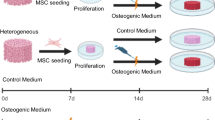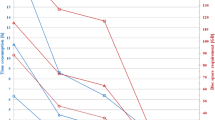Abstract
This study covers the quantification of the covalent attachment of gelatin type B (GelB) and the subsequent adsorption of Fibronectin (Fn) on poly-ε-caprolactone (PCL) surfaces, functionalised with 2-aminoethyl methacrylate (AEMA) by means of post-plasma UV-irradiation grafting. As typical surface characterisation tools do not allow quantification of deposited amounts of GelB or Fn, radiolabeled analogues were used for direct measurement of the amount of immobilized material. Bolton-Hunter GelB (BHG) and Fn were radioiodinated with 131I and 125I respectively and S-Hynic GelB (SHG) was labeled with 99mTc. Immobilisation of 131I-BHG or 99mTc-SHG on both PCL and PCL-AEMA scaffolds was performed in analogy with earlier work. SPECT images on scaffolds coated with 99mTc-SHG conjugates were acquired on a U-SPECT II camera. There was a clear difference in the amount of deposited 131I-BHG between blanco and AEMA-grafted PCL on 2D samples. No significant differences in immobilization behaviour were observed between 99mTc-SHG and 131I-BHG. Subsequent immobilisation of Fn was successful and depended on the amounts of deposited GelB. SPECT imaging on cylindrical 3D scaffolds confirmed these findings and showed that the amount of immobilized 99mTc-SHG was depth dependant. The architecture of the scaffolds strongly influences the distribution of GelB within these structures. Furthermore, there is a clear difference in the homogeneity of the protein coating when different GelB immobilization protocols were applied. This study shows that radiolabeled compounds are a rapid and accurate tool in the quantitative and qualitative evaluation of the biofunctionalisation of AEMA grafted PCL scaffolds.




Similar content being viewed by others
References
Langer R, Vacanti JP. Tissue engineering. Science. 1993;260(5110):920–6.
Woodruff MA, Hutmacher DW. The return of a forgotten polymer—polycaprolactone in the 21st century. Prog Polym Sci. 2010;35(10):1217–56.
Hutmacher DW, Schantz JT, Lam CXF, Tan KC, Lim TC. State of the art and future directions of scaffold-based bone engineering from a biomaterials perspective. J Tissue Eng Regen Med. 2007;1(4):245–60.
Chen FL, Zhou YF, Barnabas ST, Woodruff MA, Hutmacher DW. Engineering tubular bone constructs. J Biomech. 2007;40:S73–9.
Chim H, Hutmacher DW, Chou AM, Oliveira AL, Reis RL, Lim TC, Schantz JT. A comparative analysis of scaffold material modifications for load-bearing applications in bone tissue engineering. Int J Oral Maxillofac Surg. 2006;35(10):928–34.
Endres M, Hutmacher DW, Salgado AJ, Kaps C, Ringe J, Reis RL, Sittinger M, Brandwood A, Schantz JT. Osteogenic induction of human bone marrow-derived mesenchymal progenitor cells in novel synthetic polymer-hydrogel matrices. Tissue Eng. 2003;9(4):689–702.
Hoque ME, San WY, Wei F, Li SM, Huang MH, Vert M, Hutmacher DW. Processing of polycaprolactone and polycaprolactone-based copolymers into 3D scaffolds, and their cellular responses. Tissue Eng Part A. 2009;15(10):3013–24.
Shor L, Guceri S, Wen XJ, Gandhi M, Sun W. Fabrication of three-dimensional polycaprolactone/hydroxyapatite tissue scaffolds and osteoblast-scaffold interactions in vitro. Biomaterials. 2007;28(35):5291–7.
Park SA, Lee SH, Kim WD. Fabrication of porous polycaprolactone/hydroxyapatite (PCL/HA) blend scaffolds using a 3D plotting system for bone tissue engineering. Bioprocess Biosyst Eng. 2011;34(4):505–13.
Kokubo T, Kim HM, Kawashita M. Novel bioactive materials with different mechanical properties. Biomaterials. 2003;24(13):2161–75.
Ciapetti G, Ambrosio L, Savarino L, Granchi D, Cenni E, Baldini N, Pagani S, Guizzardi S, Causa F, Giunti A. Osteoblast growth and function in porous poly epsilon-caprolactone matrices for bone repair: a preliminary study. Biomaterials. 2003;24(21):3815–24.
Chen BQ, Sun K. Mechanical and dynamic viscoelastic properties of hydroxyapatite reinforced poly(epsilon-caprolactone). Polym Test. 2005;24(8):978–82.
Leung LH, Di Rosa A, Naguib HE (2010) Physical and mechanical properties of poly(E-Caprolactone)—hydroxyapatite composites for bone tissue engineering applications. Imece2009: Proceedings of the Asme International Mechanical Engineering Congress and Exposition, vol 2, pp 17–23.
Nair LS, Laurencin CT. Biodegradable polymers as biomaterials. Prog Polym Sci. 2007;32(8–9):762–98.
Cheng ZY, Teoh SH. Surface modification of ultra thin poly (epsilon-caprolactone) films using acrylic acid and collagen. Biomaterials. 2009;25(11):1991–2001.
Amato I, Ciapettia G, Pagani S, Marletta G, Satriano C, Baldini N, Granchi D. Expression of cell adhesion receptors in human osteoblasts cultured on biofunctionalized poly-(epsilon-caprolactone) surfaces. Biomaterials. 2007;28(25):3668–78.
Duan Y, Wang Z, Yan W, Wang S, Zhang S, Jia J. Preparation of collagen-coated electrospun nanofibers by remote plasma treatment and their biological properties. J Biomater Sci Polym Ed. 2007;18(9):1153–64.
Gabriel M, Amerongen GPV, Van Hinsbergh VWM, Amerongen AVV, Zentner A. Direct grafting of RGD-motif-containing peptide on the surface of polycaprolactone films. J Biomater Sci Polym Ed. 2006;17(5):567–77.
Ma ZW, He W, Yong T, Ramakrishna S. Grafting of gelatin on electrospun poly(caprolactone) nanofibers to improve endothelial cell spreading and proliferation and to control cell orientation. Tissue Eng. 2005;11(7–8):1149–58.
Marletta G, Ciapetti G, Satriano C, Pagani S, Baldini N. The effect of irradiation modification and RGD sequence adsorption on the response of human osteoblasts to polycaprolactone. Biomaterials. 2005;26(23):4793–804.
Marletta G, Ciapetti G, Satriano C, Perut F, Salerno M, Baldini N. Improved osteogenic differentiation of human marrow stromal cells cultured on ion-induced chemically structured poly-epsilon-caprolactone. Biomaterials. 2007;28(6):1132–40.
Santiago LY, Nowak RW, Rubin JP, Marra KG. Peptide-surface modification of poly(caprolactone) with laminin-derived sequences for adipose-derived stem cell applications. Biomaterials. 2006;27(15):2962–9.
Tiaw KS, Goh SW, Hong M, Wang Z, Lan B, Teoh SH. Laser surface modification of poly(epsilon-caprolactone) (PCL) membrane for tissue engineering applications. Biomaterials. 2005;26(7):763–9.
Wirsen A, Sun H, Emilsson L, Albertsson AC. Solvent free vapor phase photografting of maleic anhydride onto poly(ethylene terephthalate) and surface coupling of fluorinated probes, PEG, and an RGD-peptide. Biomacromolecules. 2005;6(4):2281–9.
Zhu YB, Gao CY, Liu XY, Shen JC. Surface modification of polycaprolactone membrane via aminolysis and biomacromolecule immobilization for promoting cytocompatibility of human endothelial cells. Biomacromolecules. 2002;3(6):1312–9.
Zhu YB, Gao CY, Shen JC. Surface modification of polycaprolactone with poly(methacrylic acid) and gelatin covalent immobilization for promoting its cytocompatibility. Biomaterials. 2002;23(24):4889–95.
Desmet T, Morent R, Geyter ND, Leys C, Schacht E, Dubruel P. Nonthermal plasma technology as a versatile strategy for polymeric biomaterials surface modification: a review. Biomacromolecules. 2009;10(9):2351–78.
Yildirim ED, Besunder R, Pappas D, Allen F, Guceri S, Sun W. Accelerated differentiation of osteoblast cells on polycaprolactone scaffolds driven by a combined effect of protein coating and plasma modification. Biofabrication. 2010;2(1):014109.
Lee H, Kim G. Three-dimensional plotted PCL/beta-TCP scaffolds coated with a collagen layer: preparation, physical properties and in vitro evaluation for bone tissue regeneration. J Mater Chem. 2011;21(17):6305–12.
Ruckenstein E, Guo W. Cellulose and glass fiber affinity membranes for the chromatographic separation of biomolecules. Biotechnol Prog. 2004;20(1):13–25.
Khalil MM, Tremoleda JL, Bayomy TB, Gsell W (2011). Molecular SPECT imaging: an overview. Int J Mol Imag. Article ID 796025, 15 pages.
Desmet T, Billiet T, Berneel E, Cornelissen R, Schaubroeck D, Schacht E, Dubruel P. Post-plasma grafting of AEMA as a versatile tool to biofunctionalise polyesters for tissue engineering. Macromol Biosci. 2010;10:1484–94.
Lee H, Kim GH. Three-dimensional plotted PCL/β-TCP scaffolds coated with a collagen layer: preparation, physical properties and in vitro evaluation for bone tissue regeneration. J Mater Chem. 2011;21:6305–12.
Van Vlierberghe S, Vanderleyden E, Dubruel P, De Vos F, Schacht E. Affinity study of novel gelatin cell carriers for fibronectin. Macromol Biosci. 2009;9(11):1105–15.
Zaidi H, Hasegawa BH. Quantitative analysis in nuclear medicine imaging. New York: Springer; 2006.
Author information
Authors and Affiliations
Corresponding author
Additional information
Ken Kersemans, Tim Desmet contributed equally to this publication.
Rights and permissions
About this article
Cite this article
Kersemans, K., Desmet, T., Vanhove, C. et al. Radiolabeled gelatin type B analogues can be used for non-invasive visualisation and quantification of protein coatings on 3D porous implants. J Mater Sci: Mater Med 23, 1961–1969 (2012). https://doi.org/10.1007/s10856-012-4668-5
Received:
Accepted:
Published:
Issue Date:
DOI: https://doi.org/10.1007/s10856-012-4668-5




